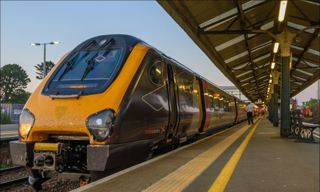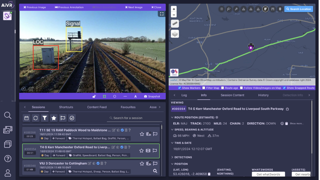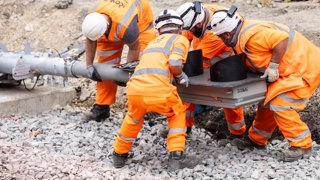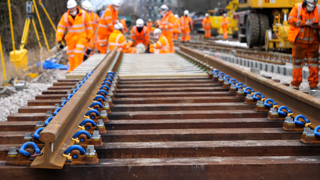October 3, 1987, marked the 2oth anniversary of the commissioning of 0400, the first Class 50.
Indeed, 1987 proved quite eventful for the Class. Firstly, there was the withdrawal of 50011 on February 23 for use as a static engine test bed in Crewe works, followed by 50006 and 50014. Then the new timetable in May 1987 witnessed the downgrading from the hardest work on Class 1 trains, due to the InterCity Sector not wanting them, to more ''secondary'' activities such as Class 21ocals between Bristol and Cardiff and Swansea; there were also four diagrams involving freight haulage previously unknown during the summer months. The summer 1988 timetable has brought a further winding down in activity, with some locomotives spare and one allocated to Lickey bank loco work. Finally, there was the Railfreight Class 50/t conversion- quite a year!
Interest in the class is, to any great extent, a relatively new phenomenon. In their days on the LMR, they were generally disliked by enthusiasts, save for the odd connoisseur, and on the WR after 1974 they were positively detested by the hydraulic fans. Present day devotees are, therefore, largely newcomers who probably know very little about the history of the locomotives in which they are interested. Twenty years on, it is timely to shed a bit of light on the early years, for, aside from some vague ideas about double heading the Anglo Scottish services, no-one bothers to mention the hundreds of thousands of miles put in on other work. The story begins sometime in the first half of 1965 when BR sent out an enquiry for a further batch of Type 4s. Almost certainly this would have been before the problems with the Brush Type 4 had manifested themselves to any extent and so there would have been competition between, at least, Brush and English Electric for the order. The options to BR would have been more of the same from Brush or something on the lines of DP2 from EE. (Something on the lines because the stepped front of this loco was no longer acceptable to BR) EE submitted its tender on June 2, but there was a long gap before even a letter of intent was sent to them, possibly as BR was watching the power units of its D1500s (now Class 47) cracking before their eyes.
1966 was a year of decisions, both by manufacturer and customer. What type of control filtration, what duties should the class be expected to cover? Eventually a design emerged which was quite unlike what had been expected in terms of its sophistication. Some people say "complexity" but that is a relative term and this is inappropriate as features such as dynamic braking and inertia air filtration were already in use quite widely abroad. True, the electronic control. System employed was advanced and it enabled the class to claim to be the best in the world in that respect as regards main line diesel traction at the time. DP2 had, of course, been running around quite happily with a basic version of this system since June 1966, what was special was the use of the current and load control unit, CUT, as the "brain" controlling a number of sub-systems for current limitation, slow speed running and wheelslip, among others. Whilst there is no doubt that both the LMR's Operating Department and CM&EE's staff would have been happy with just a basic DP2 in prefere11ce to all this high-tech, the incorporation of the advanced features was far sighted and it is unfortunate that design philosophy in Britain when seemed tostagnate somewhat, otherwise the home manufacturers would have been quite able to match the Class 59 design in 1986. History shows Class 50 as marking a milestone in the world, let alone British, traction.
Why had such a design emerged at all? Well, it was clear in 1965 that electrification beyond Liverpool and Manchester was not going to progress for some time. St8am was lingering on in the North West and the LMR continued to deploy the first generation EE Type 4 (later Class 40) on the principal services to Scotland. It is a source of mystery why this was so, for the region had a fleet of more powerful Peaks (Class 45) at its disposal wh1ch were performing, by comparison, less arduous work on the Midland main line. True, there were some new 01500s but these were being spread between (primarily) the ER and the WR. More larger Type 4s were obviously needed for work over Shap and Beattock and
it was this which sparked off the enquiry issued by BR mentioned above. It is claimed by some commentators that the 0400s were built to maintain the same standard of average speeds over the northern bank as the electrics did south of Crewe; this is rubbish. For a start, the electrics then available could not themselves have maintained such averages if the line had been electrified, they lacked the power and the prevailing speed limits were too low. Thus if a 3600 hp prime mover would have been incapable of the job, how could a diesel offering only 60% of that potential cope. It is true that the new fleet was, from new, wired f0r multiple operation, but if it was intended in 1967 to use them in pairs then why were the external jumper connections not fitted during construction?
There is no doubt that construction at Vulcan got behind schedule, as the first deliveries were initially expected to be in traffic by early 1967. This was later revised to July but it was not until September that 0400 ran onto BR metals outside Vulcan Foundry to make its inaugural trip to Chester. This was followed by a programme of trial running under a variety of situations, high speed passenger,heavy load passenger, air braked freight, slow speed creep operation, over a variety of routes, both north and south of Crewe. Acceptance by BR on October 3 enabled the locomotive to be put to use on crew training duties. Meanwhile 0401 was being put through its paces and it was during the trial running, with instruments fitted to measure the performance of the electrical machines, that the unit was found to be overpowered. Obviously this was undesirable, especially as this discrepancy was of the order of 300 bhp, but yet the works could not confirm this finding. Eventually the cause was pinpointed and appropriate steps taken.
Problems such as that caused further delay in entry to traffic and by Christmas 1967 only three had been accepted, being spread between English and Scottish depots for crew training. Once these early teething troubles had been overcome four or five units per month were being turned out, with the whole fleet in service by the end of 1968. Whether · their late arrival prolonged steam in the North West, the last area to witness its operation, is not known, but by August 1968 when steam finally disappeared, the 0400s were certainly m a commanding role in terms of West Coast traffic movement. It is the demise of steam that did the class a disservice, for enthusiasts were so busy chasing t1e dying gasps of worn out Black Fives that they failed to notice a fare more interesting and significant (the Stanier 5s were successful but hardly significant) type and so much of the early duties performed by the 0400s have gone unrecorded especially photographically.
During the day the class took charge of tra1ns go1ng north of Weaver Junction to destinations such as Blackpool, Heysham Barrow, Windermere, Carlisle and Glasgow and Perth. Further north, the trains from Liverpool and Manchester to Glasgow were also turned over to 0400 haulage whilst other daytime use saw some Class 3 parcels diagrams covered. It is worth remembering that in those days there was far more parcels traffic, and trains than exist today. At weekends they took their turn on services from Liverpool and Manchester towards Birmingham and London during a period when the AC electrics could not be used, either due to the power being switched off or diversionary routes being followed. At night, apart from the overnight sleeper and mail trains, there were the large number of freightliners which traversed the West Coast line to haul north of Crewe. Included among these were the services from Longsight and Garston to Glasgow. It would be interesting to know what load limit a single loco was allowed up Shap and Beattock. A variety of short haul freight traffic was also moved around the North West be it over the Settle and Carlisle, round the ' Cumbrian coast or between Liverpool and Manchester; similar activity also went on in Scotland.
It would be nice to be able to say that the early service experience was good but that would not be true. A variety of failures occurred which were later reported "no fault found" and it was not until the problematic 0448, a real black sheep in its first few weeks of use, was taken out for special examination that it was appreciated just how full of "spikes" were the electronic control systems. These spikes could cause voltage surges which, 1n turn, could cause engine shutdown, for example, for no reason and 0448 was past master at this; indeed, so the story goes, on one trip the driver actually broke down in tears at having to press the engine start button for the umpteenth time. With suitable modification a couple of weeks but another problem was giving rise to a serious drop in availability, cracked cylinder heads. A manufacturing fault was the cause and the result was water ingress into the cylinders. Now water will not burn or compress and the cylinder compression stroke would result in the connecting rod bending. Further, excessive scraping of the cylinder liner left too little lubricating oil, causing piston seizures. The upshot was a programme of cylinder head changing and removal of one of the scraper rings on the pistons. This work was done, in the main, at either Crewe or Vulcan works with a power plant change. At the height of the troubles it seems there were only 48 serviceable engines, with damage sustained to one engine putting the block beyond economic repair. It was therefore ironic that the main reason for the order of the class, the successful operation of the t 6CSVT power unit in DP2, should prove to be the cause of so much trouble.
The manufacturers had guaranteed an availability of 84% and they were penalised heavily during the first years in traffic by failing to meet this target. Regrettably, it has not been possible to find out whether diagramming actually called for this percentage but at times the Operating Department did call for 90% of the fleet to cope with peak traffic. It was during 1968 that the Achilles Heel of the class emerged with failures of the main generator at an unacceptably high rate. Steps were taken to improve commutation but right to the present day main generator failures have served to reduce availability.
Maintenance was primarily the responsibility of Crewe Diesel Depot through the allocation system then used by the LMR for its fleet did not show the class as actually based there, being D05, Stoke division. Many other depots became involved in maintenance, arising of their daily work across the North West and Scotland. EE had engineering representatives based at Crewe, Carlisle and Pomade in the early years to assist depot staff and keep ‘down time’ to a minimum. Tire turning was often carried out at Tyseley, sometimes Willesden, so appearances away from the usual routes were possible. With their additional features, such as dynamic braking and slow speed control, there was more to go wrong and so more to maintain, but BR certainly got its money’s worth for this cost in terms of savings in brake and tyre wear and the versatility and ease of operation. This versatility was increased during 1969 and 1970 when the decision was taken to fit external jumper connections to allow all the class to operate in multiple; previously only D400 had a full set of jumpers and connections, whilst D401 had connection ports only. It then became possible to schedule pairs of locomotives on main Anglo Scottish daytime trains.
The gradients north of Carnforth are such that a single Type 4 hauling the booked 13 coach loads could not maintain, by a long way, the line speed limits. Using two Class 50s in multiple would relieve the problem and the schedule of the Royal Scot from May 1970 was reduced by over three quarters of an hour to under six hours; the train called intermediately at Crewe and Carlisle. All five of the daytime Euston-Glasgow workings were double headed, as also were the morning down Birmingham and Liverpool to Glasgow and return evening services. Ultimately it was planned to schedule the Royal Scot at a level five hours. These faster schedules only lasted twelve months, for Government approval for electrification through to Glasgow brought the addition of large amounts of recovery time to cope with the disruption to running due to the consequent engineering work. Double heading continued until the full electric service was introduced in May 1974.
Without details of diagramming in 1969 it is not possible to see what duties the class gave up to allow the use of extra locomotives for the double-heading but it seems likely that from 1970 rostering would have required a high level of availability. Certainly there were instances of only one locomotive being available instead of the booked pair but these were not as great as some commentators would have us believe. A further relevant point here was the appearance by the class during the day on MGR trains to Fiddlers Ferry, lronbndge and Rugeley power stations, not booked for them, but covered due to the non-availability of a slow speed fitted Class 47. There seems to have been some variability in power outputs between individual machines, judging by published performance data, but when the Operating Department laid the blame for late running at the door of the class, a survey of running over a two week period showed that this was unjustified and that sloppy operating was the cause. By early 1974, with most of the electrification work complete, a single Class 50 in good form could easily keep time on the accelerated timings booked for a pair.
Meanwhile other daily activity continued as before, with dominance of the Class 1 duties north of Crewe and other Class 3 and 4 work. This ensured that examples could still be seen all over the North West, sometimes straying into the East and West Midlands and, when on track from Crewe works, along the North Wales coast. In those days there were very few haulage fans and the front coach was invariably devoid of enthusiasts; what price today for a 50 from Manchester to Blackpool then a daily occurrence. Introduction of the full electric service in 1974, with transfer of 35 units to the WR, brought a downgrading for the remaining 15. Except during Sunday diversions there was very little Class 1 mileage for them to run, save for the Liverpool/ Manchester to Preston legs of trains bound for Scotland. Instead there were now appearances on as wide a selection of duties as possible, from track lifting and local trip freights to Class 6 and 7 freights booked over the Settle to Carlisle and freightliner traffic.
More appearances were made at power stations on MGRs, vindicating the decision to install from new the necessary slow speed control gear. During the succeeding two years, before final transfer of all 50 to fhe WR mileage would have been low but both availability and reliability were extremely high, perm1tt1ng favourable comparison with any other Type 4 and very little difference to the redoubtable Class 37s.
WR ownership did not bring to an end the association of the class with the LMR, for from the start on that region Class 50 has worked regularly on the Penzance/Plymouth to Birmingham road on services going forward to the North West and Scotland. Training of Birmingham men in 1976/7 saw limited diagramming on the Paddington/Reading to the West Midland route and once at Sattley there have been numerous instances of the LMR borrowing one to cover for a non- available Class 47 on freightliner work, though the odd night time turn has been fitted into the diagrams over the years. Equally on Sundays the LMR has used a spare Class 50 for dragging electrically hauled Class 1 trains between Birmingham and Nuneaton or Rugby whilst they have also been fairly regular visitors on the Wolverhampton to Shrewsbury road. Whilst works repairs continued to be the responsibility of Crewe the LMR was prone to borrowing an overhauled machine for a short while after its release by the WR demanded it back. Inevitably it was freight in the Cheshire area which was involved. During the 1980s winter timetable diagramming brought a class member to Crewe on the 2000 Cardiff mail, the return working being at 0204. By using Birmingham drivers it had been possible for the class to revisit old haunts in Liverpool and Manchester when nothing else was available to replace them at Birmingham. On July 30, 1987 50002 worked a Paddington to Oxford, extended through to Manchester s a relief to a late running service train, possibly the first instance of a loco and coaches all in Network SouthEast livery appearing at Piccadilly. During the winter 1987 timetable on 0703 Paddington to Manchester and 1401 return found a Class 50 covering for a non- available Old Oak Common Class 47/4 on a number at occasions; No. 50036 was apparently the last during early May.
With the class now in decline and InterCity preferring Class 47/4 for inter-regional work from Birmingham to the South West, there is less opportunity for LMR running than for a long while. One wonders whether the association between the fleet and the LMR will reach 25 years but certainly the last 20 have provided plenty of variety, interest and a few surprises to enliven the rail scene on the region. Who knows,m it is quite feasible that a preserved example may find a final resting place at Bury or Butterley, continuing the long relationship.
- This feature was published in RAIL 85 in October 1988.















Login to comment
Comments
No comments have been made yet.